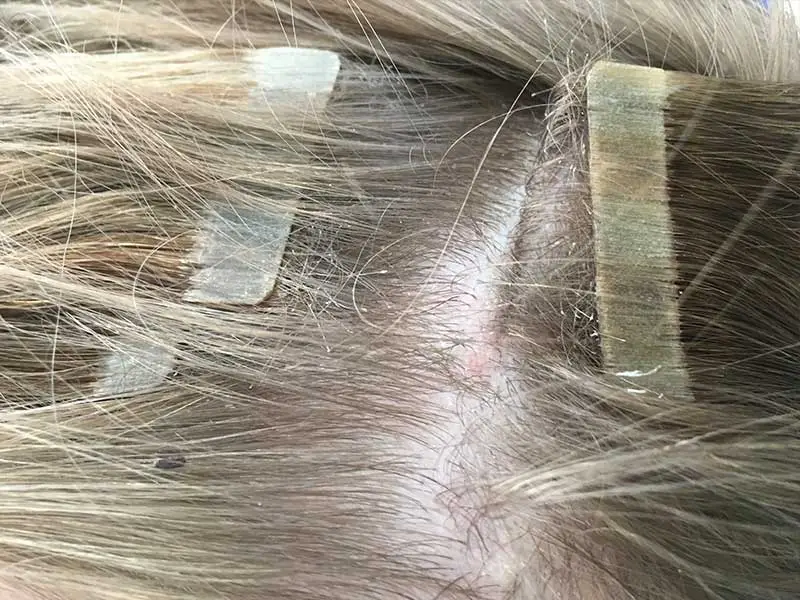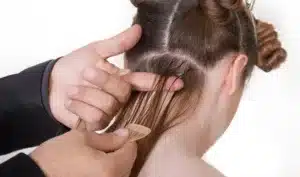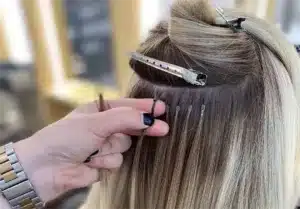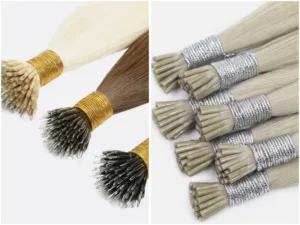Hair extensions give volume, length, and versatility. But many professionals and clients worry: will they damage natural hair? This fear is valid—poor application, bad-quality hair, or improper maintenance can cause breakage and thinning. Let’s break down the facts.
Yes.Hair extensions can cause damage, but only when they’re low quality, applied incorrectly, or not maintained. The good news? With proper installation, the right methods, and premium-grade hair, extensions can enhance your look without compromising hair health.
Extensions are a powerful tool when used correctly. Let’s explore how to protect your natural hair while enjoying the beauty of extensions.

What Causes Hair Damage from Extensions?
Some clients worry about thinning or breakage after wearing extensions. These concerns often come from specific mistakes that can be avoided.
Hair damage typically occurs from:
- Using poor-quality, heavily processed hair
- Incorrect installation by undertrained stylists
- Excessive tension or weight on natural hair
- Neglecting daily and weekly maintenance routines

Dive Deeper
Hair damage from extensions can stem from several key areas:
1. Low-Quality Hair Material
Cheap hair extensions are often collected from multiple donors, stripped of cuticles, and heavily processed with acid or silicone. These wefts shed, tangle, and pull on your natural hair.
| Hair Type | Quality | Result on Natural Hair |
|---|---|---|
| Full Cuticle Hair | High | Smooth, long-lasting, safe |
| Acid-Washed Hair | Low | Tangles, frays, causes breakage |

2. Poor Installation Technique
Stylists who are inexperienced or undertrained might place extensions too close to the scalp or apply too much weight. This creates tension, which pulls on the follicle and causes traction alopecia.
3. Wrong Method for Hair Type
Some clients use keratin bonds or tight weaves on fragile, fine hair. This mismatch creates stress that leads to damage.

4. Lack of Maintenance
Not brushing regularly, using the wrong products, or skipping deep conditioning causes matting at the root or tangling between the weft and natural hair.
What is the Healthiest Method of Hair Extensions?
Many clients ask: “Are there any hair extensions that don’t damage hair?” The answer is yes—but only if matched correctly to hair type, lifestyle, and installed by a skilled stylist.
Dive Deeper
Here’s a breakdown of the most popular methods and their impact:
Clip-In Extensions
Type: Regular Clip In Hair, Lace Clip In Hair,Seamless Clip In Hair,Invisible Clip In Hair
- Best for occasional wear
- Least damaging
- Installed and removed daily
Pro: No glue or tension on roots
Con: Not ideal for long-term wear
CLIP IN HAIR
Tape-In Extensions
Type: Regular Tape In Hair, Micro Clip In Hair,Stitched Clip In Hair,Invisible Tape In Hair
- Lightweight, flat adhesive wefts
- Must be professionally applied and removed
Pro: Low tension when installed properly
Con: Can slip if not maintained or washed too soon
TAPE IN HAIR
Sew-In (Weave) Extensions
Type: Machine weft Hair, Genius weft Hair,Handtied weft Hair,Flat Weft Hair
- Braided base/Beads installation, weft sewn in
- Common with thick/coarse hair
Pro: Long-lasting, secure
Con: Can cause tension if braids are too tight
HAIR WEFT
Keratin Bond (Fusion) Extensions
Type: Flat Tip Hair,V Tip Hair,U Tip Hair
- Heat-bonded with keratin glue
- Long-lasting and discreet
Pro: Natural movement and feel
Con: Removal requires acetone and expertise, may cause breakage if not done correctly
KERATIN HAIR
Micro-Link (Beads) Extensions
Type: I Tip Hair,Nano Tip Hair,Micro Ring Hair
- Small silicone-lined beads secure extensions to natural hair
Pro: No heat or glue needed
Con: Can slip or pull if too much weight is added per strand
KERATIN HAIR
Halo Extensions
Type: Halo Hair Extensions
- Temporary, no-install headband-style extensions
Pro: Zero damage risk
Con: Not suitable for active lifestyles or updos
Halo Hair Extensions
Does Hair Extension Quality Affect Hair Health?
Absolutely. The quality of hair extensions directly affects your natural hair’s health and the extensions’ performance.
Dive Deeper
Not all hair is created equal. Here’s what you need to know:
Single Donor vs. Multi Donor Hair
- Single donor: All strands from one person, same direction, full cuticle
- Multi donor: Mixed sources, may cause tangling and uneven wear
Full Cuticle Hair
- Cuticle remains intact and aligned
- Prevents matting and retains moisture
Chemical Processing
- Harsh acid baths or silicone coatings weaken the hair
- They look good initially but deteriorate quickly
| Quality Marker | High Quality | Low Quality |
|---|---|---|
| Donor Type | Single | Mixed |
| Cuticle Alignment | Full, intact | Stripped |
| Chemical Processing | Minimal, gentle | Heavy acid treatment |
| Longevity | 1–2 years | 2–3 months |
Low-quality extensions don’t just tangle and shed—they cause friction, matting, and breakage. For professionals, investing in quality ensures client satisfaction and hair safety.

How to Choose Hair Extensions Without Damaging Your Hair
Choosing safe extensions begins with understanding your client’s hair type and lifestyle.
Dive Deeper
Know Your Hair Type
Fine, fragile, or chemically treated hair cannot support heavy methods like bonds or tight sew-ins. Choose tape-ins, hand-tied, or halo options instead.
Match the Method to Lifestyle
Active clients who work out or swim often may need more secure methods like sewn-in or micro-beads. Office-based clients may prefer keratin or tape-ins for discretion.
Work with Certified Stylists
Only trust stylists trained in hair extension installation. Poor application is the #1 reason for hair damage.
Start with a Consultation
A proper extension consultation should include:
- Scalp health check
- Hair density evaluation
- Method recommendations
- Color and length matching
Avoid shortcuts. The right consultation can prevent serious hair issues later.
How to Care for Hair Extensions to Prevent Damage
Even the best extensions need proper care. Neglect leads to tangling, buildup, and breakage.

Dive Deeper
Brush Regularly
Use a loop brush or soft-bristle extension brush 2–3 times a day to prevent matting at the root.
Use Sulfate-Free Products
Sulfates strip hair of moisture and degrade adhesive bonds. Always choose gentle, extension-safe shampoos.
Dry Thoroughly
Never leave extensions wet. Use a microfiber towel and cool setting on blow dryer.
Sleep Protection
Use a silk pillowcase or braid hair before bed to prevent friction.
| Care Task | Frequency | Why It Matters |
|---|---|---|
| Brushing | 2–3x daily | Avoids matting, shedding |
| Washing | 1–2x/week | Maintains scalp hygiene |
| Deep Conditioning | 1x/week | Keeps extensions moisturized |
| Re-installation | Every 6–8 weeks | Prevents pulling, scalp stress |
With consistent care, extensions can last over a year without damage to natural hair.
Can You Dye Hair Extensions?
Yes—but only high-quality, full-cuticle human hair extensions can be safely dyed.
Dive Deeper
Virgin Hair vs. Processed Hair
Only virgin or minimally processed extensions can be dyed without major damage. Cheap extensions may not take color evenly or may react badly.
Tips for Coloring Extensions
- Always strand test first
- Use professional-grade dyes
- Avoid bleach unless hair is virgin
- Deep condition after coloring
Stylists should educate clients before any color work on extensions.
When Should You Take a Break from Hair Extensions?
While high-quality extensions are safe, the scalp and follicles need rest occasionally.
Dive Deeper
Signs You Need a Break
- Itchy, irritated scalp
- Hairline thinning
- Increased shedding
- Residue buildup on scalp
Recommended Break Period
Every 6–12 months, allow 4–6 weeks without extensions to let the scalp recover. Use this time to deep treat natural hair and assess its health.
Rotating methods (e.g. switching from bonds to halos) can also reduce stress.
Hair Extension Myths Debunked
Many rumors spread about extensions. Let’s clear them up.
Dive Deeper
Myth: Extensions stop your hair from growing
Truth: Hair continues to grow, but improper use or tension can lead to breakage, not growth loss.
Myth: All extensions damage hair
Truth: Only low-quality or poorly installed extensions do.
Myth: You can sleep in any extensions
Truth: Only professional semi-permanent methods are safe for overnight wear.
Myth: You can use any shampoo
Truth: Many shampoos break down tape and bonds. Only sulfate-free is safe.

What Are Safer Alternatives to Hair Extensions?
For clients who prefer less commitment or have fragile hair, there are safer alternatives.
Dive Deeper
- Halo Extensions: Zero damage, no attachment to natural hair
- Clip-Ins: Quick use, removable, and safe if worn occasionally
- Toppers or Wigs: Great for clients with thinning or medical hair loss
Always match the product to the client’s goals and hair condition.
My Opinion
At Hibiscus Hair, we’ve worked with over 300 professional clients across 60 countries. In our 15+ years, we’ve seen one thing clearly: the quality of hair and installation determines everything.
Cheap extensions cut corners. But luxury, full cuticle hair—when installed correctly—can be worn for over a year without damage. That’s why we only produce single-donor, full cuticle hair that salons can trust.
Extensions are not the enemy. Poor quality is.

FAQ
Do hair extensions stop your hair from growing?
No. Your hair continues to grow as usual. Improper application or tension can cause breakage, but not growth loss.
Are there any hair extensions that don’t damage hair?
Yes. Clip-ins, halo extensions, and properly installed hand-tied wefts are all considered low-damage options.
How long can you wear hair extensions without a break?
We recommend every 6–12 months to give your scalp 4–6 weeks of rest.
Can I wash hair extensions like my own hair?
Yes, but use sulfate-free shampoo and avoid over-washing. Focus on the scalp.
Can I reuse extensions?
High-quality extensions like hand-tied and genius wefts can be reused up to 4–6 times with proper care.
Will hair extensions feel heavy?
Not if they’re installed properly and matched to your hair density.
Can I workout with extensions?
Yes. Tie your hair in a braid or ponytail and avoid heavy sweating right after installation.
Do I need special tools to brush extensions?
Yes. Use a loop brush or soft paddle brush to avoid tugging.
Conclusion
Hair extensions won’t damage your hair if you choose high quality, install them right, and take care of them consistently.
where to buy high quality hair extensions
Hibiscus Hair Manufacturer has been dedicated to producing high-quality hair extensions for 25 years and is a recognized leader in the industry. If you are interested in finding a reliable hair extensions supplier and wholesale for your brand, please visit our website for more information:
HOME




